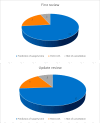Artificial Intelligence in Operating Room Management
- PMID: 38353755
- PMCID: PMC10867065
- DOI: 10.1007/s10916-024-02038-2
Artificial Intelligence in Operating Room Management
Abstract
This systematic review examines the recent use of artificial intelligence, particularly machine learning, in the management of operating rooms. A total of 22 selected studies from February 2019 to September 2023 are analyzed. The review emphasizes the significant impact of AI on predicting surgical case durations, optimizing post-anesthesia care unit resource allocation, and detecting surgical case cancellations. Machine learning algorithms such as XGBoost, random forest, and neural networks have demonstrated their effectiveness in improving prediction accuracy and resource utilization. However, challenges such as data access and privacy concerns are acknowledged. The review highlights the evolving nature of artificial intelligence in perioperative medicine research and the need for continued innovation to harness artificial intelligence's transformative potential for healthcare administrators, practitioners, and patients. Ultimately, artificial intelligence integration in operative room management promises to enhance healthcare efficiency and patient outcomes.
Keywords: Artificial intelligence; Machine learning; Management; Operating room; Perioperative.
© 2024. The Author(s).
Conflict of interest statement
The authors declare no competing interests.
Figures




Similar articles
-
The Role of Machine Learning in Management of Operating Room: A Systematic Review.Cureus. 2025 Feb 21;17(2):e79400. doi: 10.7759/cureus.79400. eCollection 2025 Feb. Cureus. 2025. PMID: 40125180 Free PMC article. Review.
-
Artificial Intelligence: A New Tool in Operating Room Management. Role of Machine Learning Models in Operating Room Optimization.J Med Syst. 2019 Dec 10;44(1):20. doi: 10.1007/s10916-019-1512-1. J Med Syst. 2019. PMID: 31823034
-
Development of Predictive Model of Surgical Case Durations Using Machine Learning Approach.J Med Syst. 2025 Jan 14;49(1):8. doi: 10.1007/s10916-025-02141-y. J Med Syst. 2025. PMID: 39808376 Free PMC article.
-
Improving the efficiency of the operating room environment with an optimization and machine learning model.Health Care Manag Sci. 2019 Dec;22(4):756-767. doi: 10.1007/s10729-018-9457-3. Epub 2018 Nov 1. Health Care Manag Sci. 2019. PMID: 30387040
-
A meta-analysis of AI and machine learning in project management: Optimizing vaccine development for emerging viral threats in biotechnology.Int J Med Inform. 2025 Mar;195:105768. doi: 10.1016/j.ijmedinf.2024.105768. Epub 2024 Dec 18. Int J Med Inform. 2025. PMID: 39708670
Cited by
-
Natural Language Processing (NLP)- and Machine Learning (ML)-Enabled Operating Room Optimization: A Preferred Reporting Items for Systematic Reviews and Meta-Analyses (PRISMA) Systematic Review Anchored in Project Planning Theory.Cureus. 2025 Apr 22;17(4):e82796. doi: 10.7759/cureus.82796. eCollection 2025 Apr. Cureus. 2025. PMID: 40416208 Free PMC article. Review.
-
Leveraging data science and AI to democratize global surgical expertise.BMJ Surg Interv Health Technol. 2024 Nov 29;6(1):e000334. doi: 10.1136/bmjsit-2024-000334. eCollection 2024. BMJ Surg Interv Health Technol. 2024. PMID: 39659515 Free PMC article. No abstract available.
-
Impact of digital surgery scheduling systems on the quality of preoperative care: a systematic review protocol.BMJ Open. 2025 Jul 16;15(7):e102034. doi: 10.1136/bmjopen-2025-102034. BMJ Open. 2025. PMID: 40669923 Free PMC article.
-
Patient Safety in Anesthesiology: Progress, Challenges, and Prospects.Cureus. 2024 Sep 16;16(9):e69540. doi: 10.7759/cureus.69540. eCollection 2024 Sep. Cureus. 2024. PMID: 39416553 Free PMC article. Review.
-
The Role of Machine Learning in Management of Operating Room: A Systematic Review.Cureus. 2025 Feb 21;17(2):e79400. doi: 10.7759/cureus.79400. eCollection 2025 Feb. Cureus. 2025. PMID: 40125180 Free PMC article. Review.
References
-
- Lee DJ, Ding J, Guzzo TJ (2019) Improving Operating Room Efficiency. Curr Urol Rep 20(6):28. doi: 10.1007/s11934-019-0895-3. - PubMed
-
- Snyder M, Zhou W (2019) Big data and health. Lancet Digit Health 1(6):e252-e254. doi: 10.1016/S2589-7500(19)30109-8. - PubMed
-
- Bellini V, Guzzon M, Bigliardi B, Mordonini M, Filippelli S, Bignami E (2019) Artificial Intelligence: A New Tool in Operating Room Management. Role of Machine Learning Models in Operating Room Optimization. J Med Syst 44(1):20. doi: 10.1007/s10916-019-1512-1. - PubMed
Publication types
MeSH terms
LinkOut - more resources
Full Text Sources

